Thomas Graals bästa barn (1918)

Swedish postcard by Förlag Nordisk Konst, Stockholm, no. 958. Photo: Svenska Biografteatern. Karin Molander in Thomas Graals bästa barn/Thomas Graal's First Child (Mauritz Stiller, 1918).

Swedish postcard by Förlag Nordisk Konst, Stockholm, no. 959. Photo: Svenska Biografteatern. Karin Molander in Thomas Graals bästa barn/Thomas Graal's First Child (Mauritz Stiller, 1918).

Swedish postcard by Förlag Nordisk Konst, Stockholm, no. 960. Photo: Svenska Biografteatern. Victor Sjöström and Karin Molander in Thomas Graals bästa barn/Thomas Graal's First Child (Mauritz Stiller, 1918).

Swedish postcard by Förlag Nordisk Konst, Stockholm, no. 961. Photo: Svenska Biografteatern. Victor Sjöström and Karin Molander in the Swedish silent comedy Thomas Graals bästa barn/Thomas Graal's First Child (Mauritz Stiller, 1918).
On the day of the wedding between the writer Thomas Graal and Bessie an argument develops between them about their respective expectations of the sex of their future first child: she wants a girl, whom she intends to call Lillian, and he a boy. Because of this quarrel, they spend the first days of their life together in mutual segregation, which worries the servants, who ask Bessie's mother to intervene.
But the conflict is soon resolved when Thomas is stung in his pride and drives away a slightly tipsy man who had begun courting his wife. In due course, Lillianus, a boy, is born, but between the couple, in a less explosive and more creeping way, a conflict arises over the different pedagogical conceptions of the two constituents of the couple: she is intransigent and strict, he is more relaxed and easy-going.
But the real reason for Thomas's discomfort is only learnt by Bessie after reading the story her husband has just finished writing: he lacks the seductive and erotic attitudes that were his wife's own before she abandoned them to devote herself completely and exclusively to Lillianus. Bessie understands, and, not without mutual satisfaction, complies with the literary dictate.
Victor Sjöström (1879-1960) was one of the most important Swedish actors and directors, famous for his poetic and touching narratives, such as Ingeborg Holm (1913), Terje Vigen/A Man There Was (1916) - by then the most expensive Swedish film made - and Körkarlen/The Phantom Carriage (1920), considered one of the best Swedish silent films.
From 1923 he worked in Hollywood under the name of Victor Seastrom, directing such films as He Who Gets Slapped (1924), starring Lon Chaney, and The Wind (1928), starring Lilian Gish. Returned to Sweden at the advent of sound cinema, he continued working there. Memorable is his last acting part in Smultronstället/Wild Strawberries (Ingmar Bergman, 1957).
Mästerkatten i stövlar (1918)
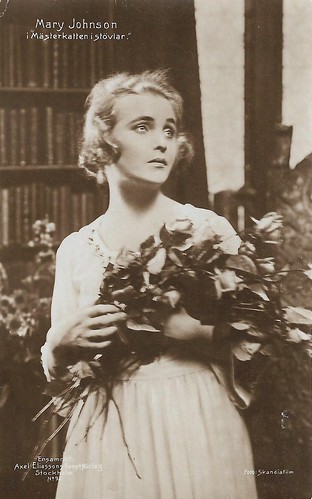
Swedish postcard by Axel Eliassons Konstförlag, Stockholm, no. 92. Photo: Skandia Film. Gösta Ekman, Mary Johnson and Carl Keil-Möller in Mästerkatten i stövlar/Puss in boots (John W. Brunius, 1918).
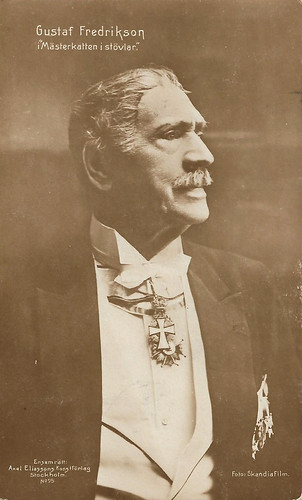
Swedish postcard by Axel Eliassons Konstförlag, Stockholm, no. 95. Photo: Skandia Film. Gustaf Fredrikson in Mästerkatten i stövlar/Puss in boots (John W. Brunius, 1918).

Swedish postcard by Axel Eliassons Konstförlag, Stockholm, no. 96. Photo: Skandiafilm. Gösta Ekman, Mary Johnson and Carl Keil-Möller in Mästerkatten i stövlar/Puss in boots (John W. Brunius, 1918).
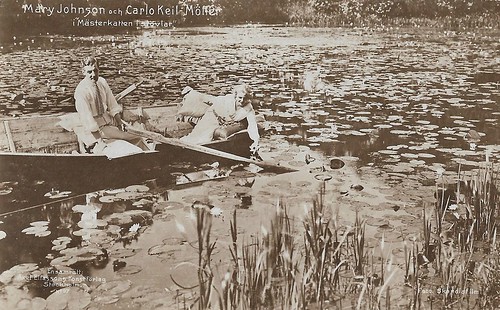
Swedish postcard by Axel Eliassons Konstförlag, Stockholm, no. 97. Photo: Skandiafilm. Gösta Ekman, Mary Johnson and Carl Keil-Möller in Mästerkatten i stövlar/Puss in boots (John W. Brunius, 1918).
Young Jörgen Steenfeld (Carlo Keil-Möller), the heir of the over-indebted estate Steensgaard, is unable to clear up its finances. He is being looked after by his old friend, "Mästerkatten" (Puss in Boots, Gösta Ekman), ie the enterprising, charming but somewhat irreplaceable Karl Konstantin Kattrup, who has been relegated from the university.
Kattrup becomes manager at Steensgaard. Steenfeld receives visits by count and countess Markdanner and her daughter Rose (Anna Carlsten). The Countess (Märtha Lindlöf) is planning a marriage between Rose and Jörgen, but Jörgen is secretly in love with the orphan Helga Anthon, called Pips (Mary Johnson). Matters are further complicated by the affair between Kattrup and Rose.
Kattrup is now turning to Steenfeld's largest creditor, Chamberlain von Schinkel (Gustaf "Frippe" Fredrikson), who is a good man and who advises Jörgen to marry Rose to set his finances straight. Kattrup also advises his friend to marry the Countess. With this planned marriage, Kattrup and Steenfeld succeed in holding another creditor from the carpet, the unpleasant schemer Bögedal (Sam Ask).
Steenfeld takes a painful parting of Pips, and the engagement is announced between Jörgen and Rose. None of them is happy: Jörgen just wants Pips, Rose just wants Kattrup. Jörgen realizes that he will make all parties unhappy if he marries Rose, so he breaks up the engagement, to the fiancée's joy. But poor Pips witnesses a love scene between Rose and Kattrup and misunderstands the situation as she confuses Kattrup and Jörgen from their point of view.
Despaired she falls out of a tree, is badly hurt and is taken care of by old von Schinkel who recognizes his youth love, Pips' grandmother. Bögedal takes advantage of the new situation to ensure that Steensgaard will be sold at an auction, where he himself intends to buy the goods. But at the auction, he is overbidden by Kattrup, on von Schinkel's behalf. The old chamberlain has adopted Pips and now grants Steensgaard to her and Jörgen. When these two get together, Kattrup can return to his Rose and everyone is happy except for the plotter Bögedal.
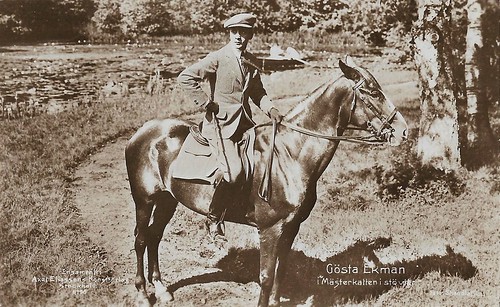
Swedish postcard by Axel Eliassons Konstförlag, Stockholm, no. 98. Photo: Skandiafilm. Gösta Ekman in Mästerkatten i stövlar/Puss in boots (John W. Brunius, 1918).
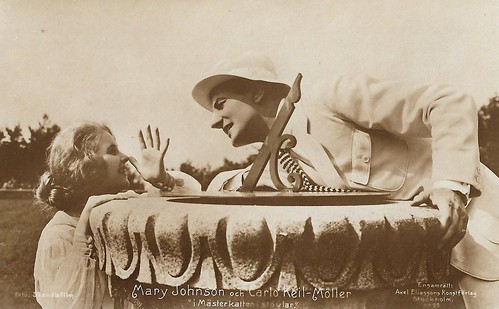
Swedish postcard by Axel Eliassons Konstförlag, Stockholm, no. 99. Photo: Skandia Film. Mary Johnson and Carl(o) Keil-Möller in Mästerkatten i stövlar/Puss in boots (John W. Brunius, 1918).
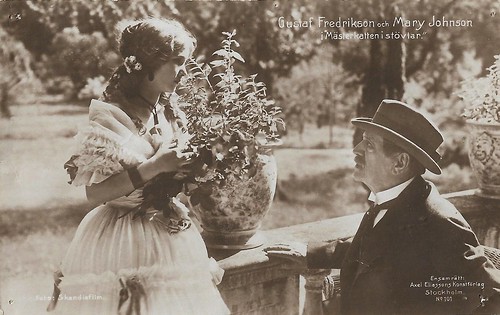
Swedish postcard by Axel Eliassons Konstförlag, Stockholm, no. 101. Photo: Skandia Film. Mary Johnson and Gustaf Fredrikson in Mästerkatten i stövlar/Puss in boots (John W. Brunius, 1918).
De landsflyktiga (1921)

Swedish postcard by Ed. Axel Eliassons Konstförlag, Stockholm, no. 293. Photo: Skandia Film, Stockholm/Svensk Filmindustri. Jenny Hasselquist in De landsflyktiga/The Emigrants/The Exiles (Mauritz Stiller, 1921).
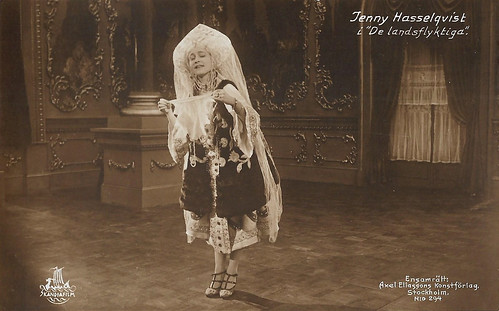
Swedish postcard by Ed. Axel Eliassons Konstförlag, Stockholm, no. 294. Photo: Skandia Film, Stockholm/Svensk Filmindustri. Jenny Hasselquist in De landsflyktiga/The Emigrants/The Exiles (Mauritz Stiller, 1921).
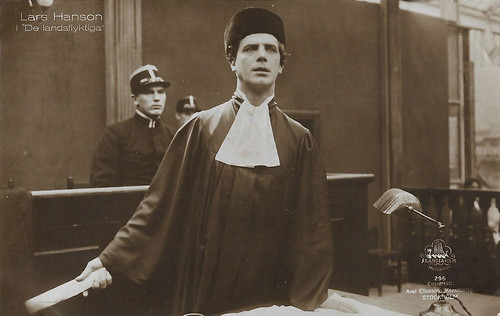
Swedish postcard by Ed. Axel Eliassons Konstförlag, Stockholm, no. 296. Photo: Skandia Film, Stockholm/Svensk Filmindustri. Jenny Hasselquist and Lars Hanson in De landsflyktiga/The Emigrants/The Exiles (Mauritz Stiller, 1921).
De landsflyktiga/The Emigrants/The Exiles (Mauritz Stiller, 1921) was shot in the studios of Filmstaden Råsunda with exteriors at Steninge castle, Stadsgårdskajen and other locations in Stockholm, shot by cinematographer by Henrik Jaenzon. The film was based on Runar Schildt's short story 'Zoja' (1920), which was published in the short story collection Häxskogen. It was during the filming of The Exiles that Stiller, who had been a Russian citizen since his birth in Helsinki, applied to become a Swedish citizen.
The wealthy Barantscheff family lives on the stately Staraja-Selo estate in the heart of Russia. Prince Ivan Ivanovich (Carl Nissen), his wife Ivanovna Stefanovna (Karin Swanstrom), their daughter Sonja (Jenny Hasselqvist) and son Yuri (Nils Ohlin), a lieutenant in the Russian navy who is recovering at home after being wounded in the war. The First World War is in full swing and storm clouds are gathering everywhere. The wealthy banker Andrei Andreyevich Myasoyedoff (Ivan Hedqvist) approaches the prince and proposes to sell the estate because of the troubled times. The prince takes the offer as an insult and refuses. Myasoyedoff has also set his eyes on Sonya, but she has already brusquely rejected him. One day, Sonya, while driving alone, rescues the young revolutionary student Vladimir Alexandrovich Mikhailoff (Lars Hanson), who is being chased by the gendarmes.
When the revolution breaks out, it is Vladimir who helps Sonja and her parents to escape across the border. The family settles in a major international city, perhaps Paris, and continues their former, carefree life of luxury, waiting for the revolution to be crushed so they can return to their former lives at home. But their inherited wealth quickly dwindles, and it is Myasoyedoff, who has also come there as a refugee, who helps them financially. He has managed to bring most of his fortune with him and is already involved in big business. The student Vladimir, a refugee from his former comrades, also arrives. One fine day, the Barantscheff family finds itself on the rocks. But Myasoyedoff is happy to oblige if only Sonya would be a little more accommodating to him.
But Sonja stubbornly refuses. In an upset scene, she rips off all the family jewels she wore to the evening's charity party and gives them as collateral instead of herself for the family's debt. Myasoyedoff takes the jewels and smilingly adds that the pledge is due at the end of the year. On New Year's Eve, Myasoyedoff is found dead in his villa, with Sonya lying unconscious outside. Vladimir, now a lawyer, defends Sonja in court. She admits that she shot Myasoyedoff when he tried to rape her. Afterwards, she threw the revolver from the balcony. But no revolver has been found.
In a break during the last day of the trial comes the explanation. Vladimir confesses to Sonja during a visit to her cell that it was he who shot Myasoyedoff on behalf of his comrades. Myasoyedoff was spying on the emigrants on behalf of the Bolshevik government, and many of their relatives remaining in Russia had already been shot. Myasoyedoff was an informer, Vladimir is the real killer, and Sonya now holds his fate in her hands. But Vladimir's defence speech in court for Sonja leads to her acquittal. She and Vladimir are united, and Sonja utters the film's final line, which it was hoped at the time would have a prophetic meaning: "Out of the darkness that oppresses us, a new Russia will one day arise, a Russia that we can both love." De landsflyktiga/The Emigrants/The Exiles is a lost film, except for a few very short fragments.
Source: Svenskfilmdatabas.
This post was last updated on 31 July 2024.
1 comment:
Thank you again
Post a Comment